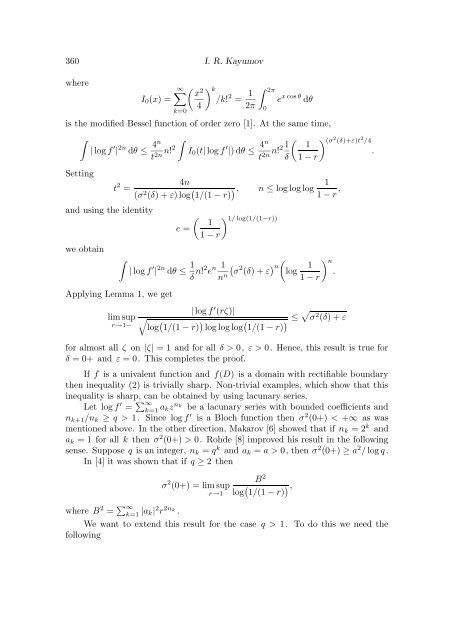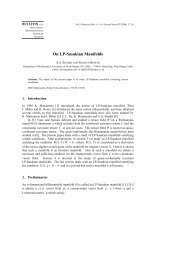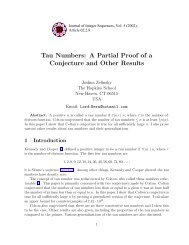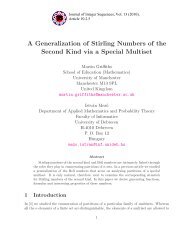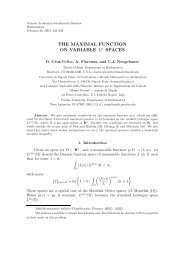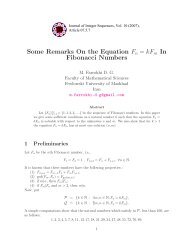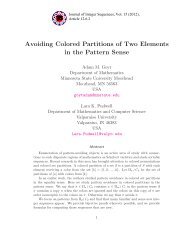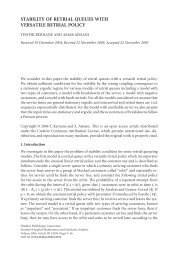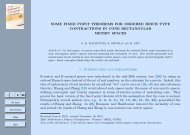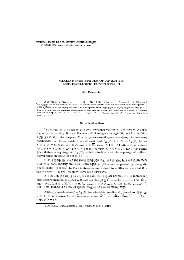the law of the iterated logarithm for locally univalent functions
the law of the iterated logarithm for locally univalent functions
the law of the iterated logarithm for locally univalent functions
Create successful ePaper yourself
Turn your PDF publications into a flip-book with our unique Google optimized e-Paper software.
360 I. R. KayumovwhereI 0 (x) =∞∑( x2k=04) k/k! 2 = 1 ∫ 2πe x cos θ dθ2π 0is <strong>the</strong> modified Bessel function <strong>of</strong> order zero [1]. At <strong>the</strong> same time,∫Setting| log f ′ | 2n dθ ≤ 4nt 2n n!2 ∫t 2 =and using <strong>the</strong> identitywe obtain∫Applying Lemma 1, we getlim supr→1−I 0 (t| log f ′ |) dθ ≤ 4n 1 ( ) (σ 12 (δ)+ε)t 2 /4t 2n n!2 .δ 1 − r4n(σ 2 (δ) + ε) log ( 1/(1 − r) ), n ≤ log log log 11 − r ,e =( 1) 1/ log(1/(1−r))1 − r| log f ′ | 2n dθ ≤ 1 δ n!2 e n 1 (σ 2n n (δ) + ε ) ( ) nn 1log .1 − r| log f ′ (rζ)|√log ( 1/(1 − r) ) log log log ( 1/(1 − r) ) ≤ √ σ 2 (δ) + ε<strong>for</strong> almost all ζ on |ζ| = 1 and <strong>for</strong> all δ > 0, ε > 0. Hence, this result is true <strong>for</strong>δ = 0+ and ε = 0. This completes <strong>the</strong> pro<strong>of</strong>.If f is a <strong>univalent</strong> function and f(D) is a domain with rectifiable boundary<strong>the</strong>n inequality (2) is trivially sharp. Non-trivial examples, which show that thisinequality is sharp, can be obtained by using lacunary series.Let log f ′ = ∑ ∞k=1 a kz n kbe a lacunary series with bounded coefficients andn k+1 /n k ≥ q > 1. Since log f ′ is a Bloch function <strong>the</strong>n σ 2 (0+) < +∞ as wasmentioned above. In <strong>the</strong> o<strong>the</strong>r direction, Makarov [6] showed that if n k = 2 k anda k = 1 <strong>for</strong> all k <strong>the</strong>n σ 2 (0+) > 0. Rohde [8] improved his result in <strong>the</strong> followingsense. Suppose q is an integer, n k = q k and a k = a > 0, <strong>the</strong>n σ 2 (0+) ≥ a 2 / log q .In [4] it was shown that if q ≥ 2 <strong>the</strong>nσ 2 (0+) = lim supr→1B 2log ( 1/(1 − r) ),where B 2 = ∑ ∞k=1 |a k| 2 r 2n k.We want to extend this result <strong>for</strong> <strong>the</strong> case q > 1. To do this we need <strong>the</strong>following


